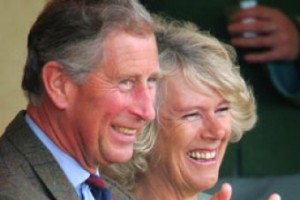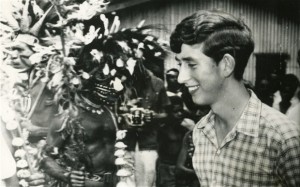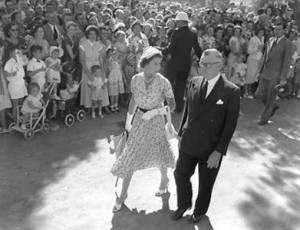Prince Charles and the Duchess of Cornwall are currently in Australia as part of a two week tour of Papua New Guinea, Australia and New Zealand to celebrate Queen Elizabeth II’s Diamond Jubilee. This tour marks the Duchess of Cornwall’s first visit to these countries but Prince Charles has a long history of involvement in the region. In 1966, he spent two terms at Geelong Grammar School in Australia as an exchange student from the Gordonstoun School in Scotland. As part of his studies, the Prince traveled to Papua New Guinea with his history tutor to learn about the history and culture of this unique commonwealth realm. The Diamond Jubilee tour therefore celebrates the Prince’s decades of interest and involvement in the region as well as the Queen’s 60 year reign.
The three commonwealth realms on the royal couple’s itinerary may share Queen Elizabeth II as head of state but they have distinct systems of constitutional monarchy. Popular perceptions of the royal family and royal tours, both in previous decades and today, also differ amongst Papua New Guinea, Australia and New Zealand.
In Papua New Guinea, there is widespread popular admiration for “Misis Kwin” as Elizabeth II is known in the local creole language, Tok Pisin. Papua New Guinea gained independence from Australia in 1975 but retained the Queen as its Head of State. In contrast to the other commonwealth realms, where the Queen’s representative, the Governor General, is nominated by the Prime Minister, the parliament of Papua New Guinea elects the nominee for Her Majesty’s approval. This collaborative system for selecting the Governor General undoubtedly contributes to the monarchy’s popularity.
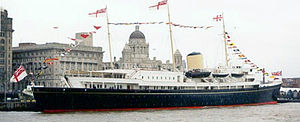
The Royal Yacht Britannia, now a museum ship in Edinburgh. Before it was decommissioned in 1997, the yacht facilitated royal visits to island commonwealth realms such as Papua New Guinea
The Duke of Edinburgh, known in Tok Pisin as “oldfella Pili-Pili him bilong Misis Kwin” visited the island as part of an extensive commonwealth tour of the region in 1956-1957 that included opening the Summer Olympics in Melbourne, Australia. The Queen’s most extensive visit to Papua New Guinea occurred during her Silver Jubilee tour in 1977 when she visited the capital, Port Moresby, Popondetta and Alotau.
In common with Tuvalu and the Solomon Islands, commonwealth realms visited by the Duke and Duchess of Cambridge this year, Papua New Guinea experienced fewer royal visits after the Royal Yacht Britannia was decommissioned in 1997. Prince Charles and the Duchess of Cornwall’s visit this week has been greeted by cheering crowds and the Prince’s decision to introduce himself in the local language as the “nambawan pikinini bilong Misis Kwin” (The number one child belonging to Mrs Queen) endeared him to the people of Papua New Guinea.
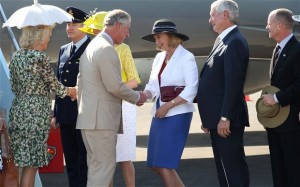
Prince Charles greeting Governor of Queensland Penelope Wensley upon his arrival in Australia. Photo credit: Tertius Pickard/AFP/Getty Images
The history of popular perceptions of the monarchy in Australia is more complicated, encompassing both extreme enthusiasm for the royal family and republican sentiment. The first royal tour of Australia, by Queen Victoria’s second son Prince Alfred, Duke of Edinburgh, in 1868, was marked by the first political assassination attempt in Australian history. The Prince was shot and wounded in the back by Irish-Australian law clerk Henry James O’Farrell necessitating a two week hospital stay before his departure.
Mishaps also occurred during royal tours of Australia in the 20th century. When the future Edward VIII visited in 1920 to thank Australians on behalf of his father, King George V, for their contributions to the First World War, his railway carriage overturned. The Prince was unhurt and made light of the incident, calling it a The Prince was unhurt and made light of the incident, calling it a ‘harmless little railway accident.’ More serious injuries occurred in Melbourne in 1954, when the enormous crowd that gathered to greet Elizabeth II on her first visit to Australia broke through police barricades. According to the Adelaide newspaper, “The Advertiser,” “Screaming women added to the tumult and some who were trampled on had to be treated by St. John Ambulance Officers.”
More recently, Australia has debated changing its government from a constitutional monarchy to a Republic. In 1999, a referendum proposing that Australia cut ties with the monarchy was defeated by 55% of the popular vote. At the time, Republican sentiment was divided by whether the Governor General would be replaced by a President nominated by the Prime Minister or by popular vote. A 2011 poll, however, revealed that support for constitutional change is the lowest it has been for twenty years. Of those surveyed, only 34% were pro-republic as opposed to 55% pro-monarchy, suggesting that the monarchy’s popularity has increased in the twenty-first century.
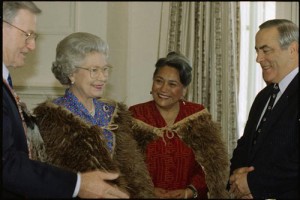
Queen Elizabeth II wearing a traditional kiwi feather cloak while giving royal assent to the Waikato Raupatu Claims Settlement Act 1995
Queen Elizabeth II’s role as Head of State has been much less controversial in New Zealand. The existence of the modern state of New Zealand dates from the signing of the Treaty of Waitangi in 1840 when over 400 Maori chiefs granted Queen Victoria sovereignty over what is now New Zealand in exchange for recognition of their land rights and receiving the status of British subjects. The Crown is therefore integral to the history of the modern state, particularly the property rights of the Maori people. Royal visits to New Zealand have been well received in the past. The Queen has visited on ten occasions and has included words of the Maori language in her speeches at Maori welcoming ceremonies, reaffirming the historic relationship between the crown and New Zealand’s first peoples.
Prince Charles’s Diamond Jubilee tour of Papua New Guinea, Australia and New Zealand encompasses three distinct constitutional monarchies that share Queen Elizabeth II as Head of State. The monarchy has been embraced as part of the national character of Papua New Guinea and New Zealand and royal visits there have traditionally been well received. Australia has gone through periods of republican sentiment and popular reactions to royal tours have ranged from an 1868 assassination attempt to a 1954 stampede by thousands of enthusiastic Australians. Recent polling data suggests that Australians are once again embracing the constitutional monarchy and will provide a warm welcome for the Prince of Wales and Duchess of Cornwall.
